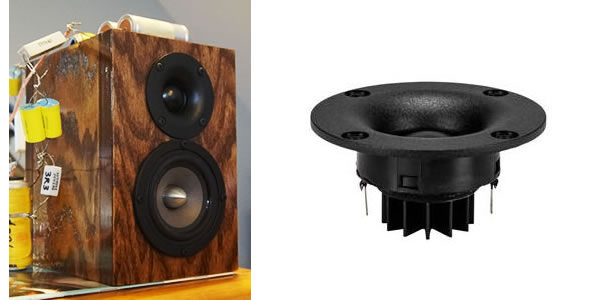|
Super-Micro Frequency Response
The above is the summed response with the BC25 wired in reversed phase. Disregard measurements below 500Hz. Measurements made without any smoothing applied. The Super-Micro is exceptionally flat all the way up to 15kHz. Looks like it doesn’t deviate by more than +/- 2.5 dB.  Super-Micro crossed at 4,500Hz. Disregard measurements below 500Hz. Now, this is what I call a proper crossover. Frequency at 4,500Hz. See how well the W3 and the BC25 sum.  Super-Micro crossed at 3,500Hz. Disregard measurements below 500Hz. This is what the response looks like when crossed at 3,500Hz. Slightly better but still not good enough. The hump is less and the depression is still there.  Super Micro Distortion ( 1/6 Smoothing, mic at 0.5 meter tweeter axis) Super-Micro Distortion Distortion is quite acceptable. Mostly 2nd harmonic (Orange Plot). Sound Quality The Super-Micros exhibit an unusually focused sound. Very little smearing. Vocals and instruments are distinctly separated. And there’s depth in the music. The kind of effect when using a good compression driver/horn setup. With their super flat frequency response, the Super-Micros are the ideal near field monitors for sound recording. For full range musical playback, just add an external subwoofer. Click on link to see Super-Micro 2.1 in use. Update (Sep 30,2016)
I decided to remove all the passive crossover parts and re-configure the Super-Micro for active bi-amping. This is easily done with my Synergy Kit. I designed the Synergy specifically for testing of 2-way speakers. Since the BC25 is the one giving the most trouble, I started with that.  BC25SC08 Response (No Smoothing, mic at 1 meter on axis, 5 msec gating) The 3 plots above are all with the Synergy’s built-in 18dB/oct crossover. Black is at 2,500Hz, Red at 3,500Hz and Blue at 4,500Hz.  Super-Micro crossed at 2,500Hz. Disregard measurements below 500Hz. This is the response of the Super-Micro when crossed at 2,500Hz (18dB/oct for the W3 and the BC25). There is a hump at the crossover point (2,500Hz). After that, a depression at 5,000Hz. That valley is not caused by the crossover. It’s the tweeter’s natural response.  Best Response at 4,500Hz crossover frequency (Disregard measurements below 500Hz) For clarity, the W3 and BC25 responses are removed. We can now see how incredibly flat the Super-Micro response is. Let’s not forget that no smoothing is applied to the plot. Even I am impressed. That’s why I said the Super-Micros will make fantastic near field recording monitors. Just to be sure, I listened to the Super-Micros at 2,500Hz, 3,500Hz and 4,500Hz. They do, in fact, sound best at 4,500Hz. It’s a joy to listen to the Super-Micros with my Synergy amps. Nothing like a good active system. |

September 17, 2016Projects
 Super-Micro Response (No Smoothing, mic at 1 meter tweeter axis, 5 msec gating) Tweeter in Reversed Phase
Super-Micro Response (No Smoothing, mic at 1 meter tweeter axis, 5 msec gating) Tweeter in Reversed Phase